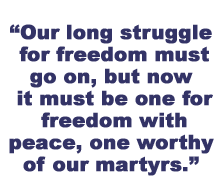THE ROAD TO FORGIVENESS
Victims and perpetrators of some of the greatest atrocities during East Timor's bid for independence face each other in a desire for reconciliation
By Sr. Mae Janet MacDonell, O.L.M.
Summer 2002
Return to Table of Contents
Print Article
My last months working with the Jesuit Refugee Service in East Timor were memorable for the privilege of witnessing to the journey of many Timorese towards reconciliation and peace. It is a journey where those who believe in the new life they have willed for themselves and their country, shoulder once more the cross of their suffering as remembered pain and grief surface in reconciliation ceremonies and court hearings. It is a journey of courage and faith. It is a pilgrimage made in hope.
In September 1999, following the vote for East Timor’s independence, militia forces (backed by the Indonesian military) herded thousands of people into trucks and carried them off to camps within Indonesian West Timor. Many of the families of the militia responsible for killings and destruction in East Timor also fled there.
 As
soon as the UN peacekeeping forces had established basic security, many
refugees, supporters of the independence vote, returned to their burned
out villages. They began rebuilding their lives in this new nation they
had suffered so greatly to defend.
As
soon as the UN peacekeeping forces had established basic security, many
refugees, supporters of the independence vote, returned to their burned
out villages. They began rebuilding their lives in this new nation they
had suffered so greatly to defend.
In September 2001, two years later, negotiations began between East Timorese political leaders, militia leaders now living in West Timor, and Indonesian government officials. The negotiations centred on the repatriation of ex-militia and their families wishing to claim East Timorese citizenship. Negotiators consulted with village leaders of the receiving communities. The influx of large numbers of ex-militia returnees into areas where their organization, if not themselves, had inflicted much death and damage, called for heroic tolerance and a willingness to be reconciled on the part of the victims of that time of terror.
The rural communities of Casa Maununu were well known to the Serious Crimes Unit of East Timor. They had been the victims of some of the greatest atrocities inflicted by the Mahidi, a branch of the Indonesian-backed militia. Now these two communities had just received over 2,000 ex-Mahidi members.
In an attempt to lower the tension until the slower juridical process could take action, a group of students, themselves members of families of victims, organized a grassroots truth and reconciliation event in their own communities.
With the help of a local human rights unit, the students convinced their families and neighbours of the value of taking positive action, of the need to express their feelings of grief and anger in an appropriate manner.
And so they approached perpetrators, some of high level and others more peripherally involved in crimes in the Casa Maununu area, and invited both sides to a face-to-face monitored encounter.
On the first day of a two-day encounter, recourse was had to a panel from the Serious Crimes Unit, the Truth and Reconciliation Commission, and Human Rights officials. Two hundred and fifty village participants had the satisfaction of firsthand legal information and of the process of justice expected in the cases registered in their villages.
On the second day, only people from the grassroots communities were allowed to speak. Victims and perpetrators faced each other in a voluntary and committed desire to begin a reconciliation process.
Painfully, stories were retold by the victims, sometimes details were clarified by those involved in the crime. Most of the latter declared that they were prepared to face justice. Their presence at this event was seen by the victims as a step towards forgiveness.
For some of the victims, it was a consolation and lessened the pain to know now where the bodies of their dead had been taken and perhaps to be able to claim them. At the end of the day everyone knew that this was only a beginning of a long healing process, but it was a beginning.
In the beautiful mountain village of Ermera, I was present at another service of reconciliation in 2001. The family and parishioners of Fr. Hilario Madeira, on the second anniversary of his death, carried his body to a crypt in the Ermera church. He, along with two other priests and 200 parishioners, had been murdered in the Suai church massacre in 1999.
At this service, an aged member of the Timorese resistance movement, dressed in his equally aged uniform, declared, “Our long struggle for freedom must go on, but now it must be one for freedom with peace, one worthy of our martyrs. We must not let ourselves go down to the level of those responsible for the horrors that grieve us still. We must believe that justice within the law will deal with them. We must pray that they know God’s mercy and ours. Long live our struggle for justice and peace.”
It is in listening to and remembering such stories that I am called to honour those heralds of hope of East Timor and the many places throughout the world where similar action is taken. I am grateful for the riches they have bestowed on all of us in their witnessing to nonviolence, to justice and peace. They have shown us some necessary steps on the steep road to forgiveness and new life.
Return to Table of Contents
Print Article